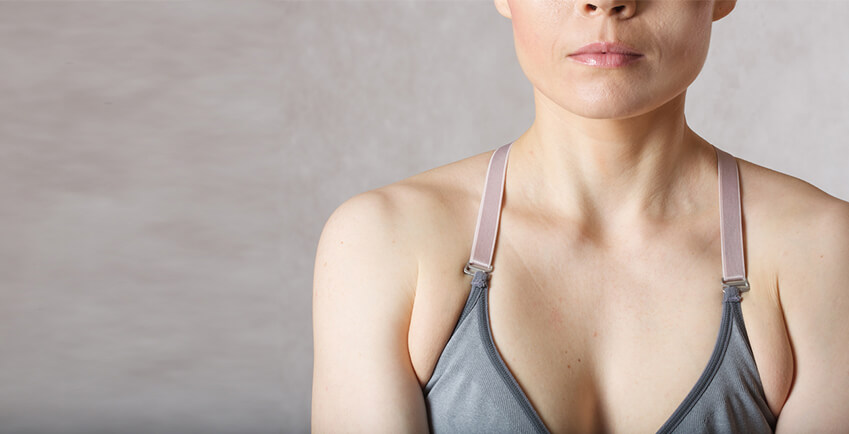Many women, and rarely even men, develop lumps in their armpits. In case of women it typically occurs either when a girl starts having her periods or when a woman gets pregnant or starts breast feeding. The appearance of such lumps in women towards the end of their menstrually active life can also be a cause of anxiety regarding cancer at that age.
Most of these lumps are what is known as Axillary Breasts.
Why does an axillary breast develop?
When the baby is in the womb, a milk ridge develops, which extends from the armpit to the groin. By the time the baby is born, most of the ridge disappears, only leaving tissue in the front of the chest where a breast will form when the girl child reaches close to puberty. In the male child, under the influence of the male hormone, that breast tissue will not enlarge but will stay undeveloped.
If the milk ridge in the armpit or axilla does not go away, it continues to develop along with the normal breast of the girl. Sometimes it may increase in size when hormone levels are exceedingly high, such as during pregnancy and breast feeding. When the hormone levels fluctuate, as around menopause, it may rarely increase in size as well.
Often we see remnants along the embryological milk ridge elsewhere on the trunk, in the form of an extra nipple or a tiny bit of breast tissue. They are often ignored by the layperson as moles or skin tags.
What should I do when I see a lump in the axilla?
You should definitely seek an examination by a doctor. The doctor will examine you and confirm that the lump is soft or firm to touch and moves under the skin. These are usually the two most important observations that indicate that it is not likely to be cancerous.
If you have had mild fever for some time with loss of appetite and loss of weight, it is possible that the lump may be due to Tuberculosis in the lymph glands of the armpit, which is not uncommon in our country. This is why early detection, diagnosis and treatment are particularly important.
The lump can sometimes also be an cyst of the sebaceous glands in the skin (called sebaceous cyst). A sebaceous cyst can rarely get infected and be difficult to control in the hair bearing and sweaty axillary skin. It can be easily removed under local anaesthesia and should be done without much delay. A stitch in time really saves nine here.
Other rare possibilities are a mass made up of blood vessels called vascular malformation, a benign swelling of fat called lipoma, and perhaps an intractable condition of infected sweat glands called hidradenitis suppurativa.
How do we know it is axillary breast and nothing else?
After thoroughly examining you, the doctor may advise tests to confirm the diagnosis. The simplest test for confirmation is an ultrasound examination which shows what tissue the swelling is made up of, its extent and whether it is attached to any important structures in the armpit such as blood vessels or nerves. In most cases, this test also confirms that it is not Tuberculosis or Cancer?
The doctor may also decide to run some blood tests and a doppler examination if it is found necessary.
When should I seek treatment for the axillary breast?
If the swellings are painful or if they are too big causing either discomfort or an inability to wear a certain type of clothing, you can consider their removal surgically. Pain in axillary breasts can be associated with menstrual periods or it can be a constant pain along the inner arm due to trapping of a nerve. In a person above the age of 40, any NEW lump should ideally be removed and pathological examination should be done.
Mostly patients request removal for discomfort, accumulation of sweat in the armpits and inability to keep arms by the side. Women often complain that sleeveless clothes cannot be worn with the unaesthetic looking lumps in the armpits.
Can my axillary breast be removed without cutting the skin?
Axillary breasts are usually of two types: Sessile (broad based, with little excess skin) and Pedunculated (Narrow based and hanging, with excess skin).
If the lump contains only fat, is sessile and there is little excess skin, it may be possible to remove it with just liposuction. Ultrasound assisted liposuction and laser liposuction also help the skin to contract and tighten.
However the more common situation is that the lump is made up of a combination of firm breast tissue and fat, it is narrow based and there is excess expanded skin. The hair bearing skin in the armpit also expands over the lump and cannot retract. So often, an ellipse of the extra skin needs to be removed, along with open excision of the gland so as to give an aesthetic outcome. Care is taken to preserve any nerves around the lump, if possible. All the extra fat is removed by liposuction. The wound is closed with fine stitches. Care is taken not to extend the suture-line beyond the borders of the arm pit, either onto the chest wall or onto the back, so that it is not seen with the arms at the sides.
The tissue removed is always sent for pathology examination to confirm that there is no cancer or Tuberculosis.
Can I opt for injections to dissolve the swelling?
The option of just fat dissolving injections feels attractive due to its simplicity and the fact that there are no cuts involved. But the armpit contains important nerves, vessels, and veins. The injections can damage them. Moreover, the spread of the drug in the injections cannot be controlled. The excess expanded skin also cannot retract with injections. So, injections are very likely to give unpredictable outcomes and cause serious side effects. They should therefore not even be considered for this condition.
What are the precautions I should follow after the surgery?
The most important precaution is to limit stretching movements of the shoulders for about a month. Avoid activities like gym, riding a bike or raising arms while working at home or in office. Do not lift weights of any kind.
The wound care instructions vary as per individual plastic surgeon’s routine. Do listen to your doctor’s advice carefully. Usually the dressings are off within a week. You can do non laborious work after 2-3 days. Some doctors put suction drains to prevent fluid accumulation. Those are usually removed after 48 hrs.
What can go wrong?
If you do not have any medical problems, the operation done under general anaesthesia is very safe. Discharge from hospital is within 12-24 hrs.
Mild pain, temporary swelling, numbness, skin irregularity and unevenness should be expected. Rarely there can be burning pain along the inner arm. This is due to nerve irritation and improves within a month but rarely may persist for up to 6 months.
Sometimes fluid or blood may collect in the wound and may require drainage. Minor wound problems are sometimes seen because of the hairy and sweaty nature of the local skin.
The scar typically takes a few months to settle. You must wait for a minimum of three months for full improvement in the contour and the scar.

